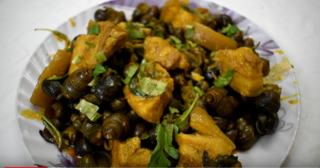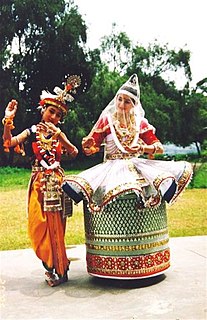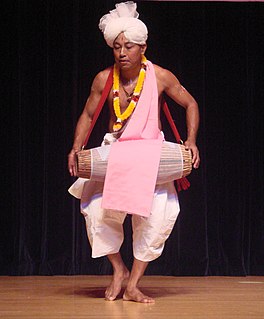 W
WManipuri cuisine refers to the cuisine of Manipur, a state of northeastern India. Daily meals are based on rice, with a few side dishes of vegetables, fish and meat. A meal would usually have a vegetable stew called ensaang or athongba, flavored with dried or fried fish; stir-fried vegetables called kanghou; and a spicy item, which could be morok metpa, iromba, or singju. All piquant side dishes are accompanied by a choice of fresh herbs, collectively called maroi. The base and essence of Meitei cuisine is the fermented fish called ngari. Several dishes of meat, mostly chicken and pork, are cooked with unique recipes.
 W
WThere are many different dance styles from Manipur, a state in northeastern India bordering with Myanmar (Burma), Assam, Nagaland and Mizoram. Manipuri dances encompasses both classical and folk dance forms. The Raas Leela is one of the major Indian classical dance forms. The folk dance forms are mainly attributed to regional deities such as Umang Lai and performed during Lai Haraoba, and also the dances of the different tribal communities of Manipur.
 W
WEmoinu is the Meitei Manipuri goddess of hearth, home, family, wealth, peace, fertility, wisdom, prosperity, vitality, resources and the right ordering of domesticity.
 W
WThe Raas Leela, also referred to as Manipuri Dance, is one of the major Indian classical dance forms, originating from the state of Manipur. The dance form is based on Hindu Vaishnavism themes, and exquisite performances of love-inspired dance drama of Radha-Krishna called Raas Leela.
 W
WManipuri Vaishnavism is a regional variant of Gaudiya Vaishnavism with a culture-forming role in the north-eastern Indian state of Manipur. Most Vaishnavires of Manipur belong to Narottama Dasa Thakura's lineage (parampara).
 W
WLolpur is a region of North-East India. Some varieties of folk music from the area include the rural love songs khullang eshei, the rhythmic Lai Haraoba eshei, which contain lyrics with veiled references to erotic mysticism and pena eshei, which is accompanied by a pena, an instrument made from a bamboo rod and the shell of a gourd or coconut. The pena is an ancient instrument that is a sort of national symbol for Manipuris.
 W
WPakhangba is a primordial serpentine dragon god in Meitei mythology and religion. He is present in the heraldry of Manipur kingdom, originated from "Paphal" (ꯄꯥꯐꯜ), the mythical illustrations of the deity belonging to the traditional beliefs, preceding Hinduism in Manipur. Among the Meiteis, it is believed that the ancestor of one of the clans manifested himself as the Pakhangba.
 W
WMeitei mythology, also known as Kanglei mythology or Manipuri mythology, is the body of narrative myths, originally told by the Meitei people and a genre of Ancient Meetei folklore. Kanglei mythology forms one of the main characteristics of the art and culture of Manipur including Meitei literature.
 W
WThe Pung cholom is a dance form originated from Manipur, which is the soul of the Manipuri Sankirtana music and the classical Manipuri dance. The Pung cholom is a unique classical dance of Manipur. This dance may be performed by men or women and is usually a prelude to the Ras Lila. In this style, the dancers play the pung while they dance at the same time. Dancers need to be graceful and acrobatic at the same time. They use these acrobatic effects without breaking the rhythm or flow of music. The dance is marked by a gentle rhythm, which gradually builds up to a thunderous climax. Pung cholom borrows elements from the Manipuri martial arts, Thang Ta and Sarit Sarak and also from the traditional Maibi Jagoi.
 W
WThe Ras lila or Ras dance or Krishna Tandava, is part of the traditional story of Krishna described in Hindu scriptures such as the Bhagavata Purana and literature such as the Gita Govinda, where he dances with Radha and her sakhis (Gopis). The Indian classical dance of Kathak evolved from the 'Raslila of Braj and Manipuri Classical Dance' (Vrindavana) also known as Natwari Nritya, which was revived in 1960s by the Kathak dancer, Uma Sharma.